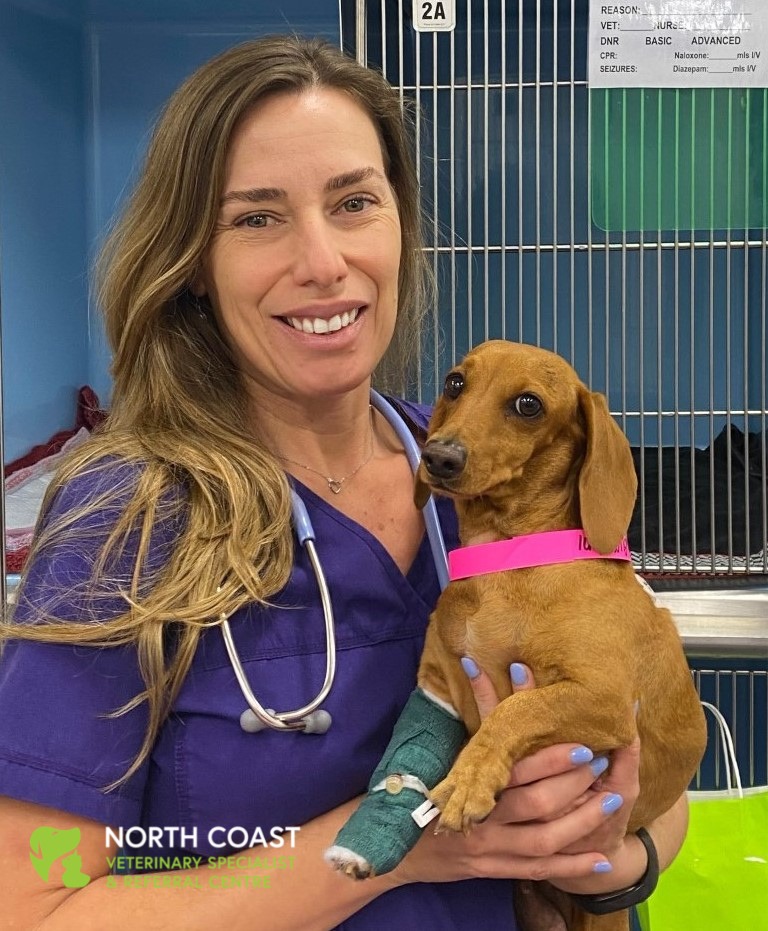Type I IVDD is a common canine spinal disease that can affect a large variety of breeds but is more common in young to middle-aged chondrodystrophic breeds. The most common presentation in these breeds is hindlimb ataxia or inability to ambulate due to thoracolumbar cord compression/injury from the extruded disc, this is what we will be looking at in more detail today.
We will start by briefly going through the components of a neurological examination with important points that are pertinent to thoracolumbar IVD extrusion then discuss diagnosis, management, and prognosis. Remember that a thorough history and physical examination is always necessary for these patients as other conditions such as bilateral cruciate disease or aortic thromboembolisms can appear similar to thoracolumbar IVDD. The signalment will also be very important in understanding the likely cause of the clinical signs of canine spinal disease.

NEUROLOGICAL EXAMINATION
The neurological exam is something that can take time to perform properly but it is of great use when trying to neurolocalise a lesion. Simple questions you should ask yourself.
Is the dog presenting with a neurological problem? If the answer is yes the following neurological examination should determine the neuroanatomic localisation.
The exam is broken up into six different sections:
Behaviour and mentation
Involves distance examination and reflects the integrity of the cerebrum as well as the brainstem. Abnormalities suggest an intracranial neuroanatomic localisation.
Cranial nerves
We won’t go through the testing of all of these in this blog but remember what nerves each test check.
Gait/attitude/posture (GAP)
1. Gait: Strength and coordination are key, assess the patient on a non-slippery surface and observe the walk. Categorised into:
a. Ataxia (vestibular, cerebellar or proprioceptive)
> Paresis: inability to support weight or generate a gait, assumes the presence of voluntary motor function.
> Plegia: Absence of voluntary motor function.
b. Weakness (UMN or LMN)
c. Lameness (LMN or orthopaedic)
2. Attitude: The position of the patient’s eye and head in relation to the body.
a. Head tilt
b. Head/body turn
3. Posture: Position of the body with respect to gravity.
a. Wide based stance, root signature, Schiff-Sherrington, etc.
Postural reaction
Neurological responses aimed at maintaining the body and head in the upright posture. Most useful in identifying subtle deficits of strength and coordination. Also very helpful in determining if the dog has a neurological disease.
Hopping, proprioceptive and tactile placing, hemiwalking, wheelbarrowing and extensor postural thrust.
Spinal reflexes
Tests the integrity of the sensory and motor components of the reflex.
1. Absent or reduced: complete or partial loss of either sensory or motor nerve (LMN)
2. Normal
3. Exaggerated: abnormal descending pathway from the brain and spinal cord that normally inhibit the reflex (UMN)
4. Forelimb reflexes: The most useful one is the withdrawal reflex C6-T2 as well as the triceps and biceps reflex.
5. Hindlimb reflex: Most useful ones are the withdrawal (testing the sciatic nerve L7-S3) and the patellar reflex (testing the femoral nerve L4-6).
6. Others: Anal sphincter (pudendal nerve S1-3 and the cutaneous trunci (lateral thoracic nerve cranial to C8-T1)
Sensory evaluation
This is the most important part of the neurological examination with regard to prognosis.
Superficial and deep nociception; superficial is the sensation of the skin/subcutis and deep is periosteal nociception. The presence or absence of deep pain changes the prognosis dramatically. To check for deep pain you need to use an instrument and squeeze the bone with it. Keep in mind that when assessing for pain a conscious acknowledgement from the brain is required – a head turn or vocalisation or trying to bite. A withdrawal of the limb is NOT a confirmation of intact pain, this is just the spinal reflex.

NEUROLOCALISATION
The location of the neurological lesion will change the findings of the neurological examination. A T3-L3 neuroanatomic localisation for an IVDD canine spinal disease would be
- Normal behaviour, mentation and cranial nerves.
- Normal forelimbs (normal tone, postural reactions and reflexes)
- Gait: either hindlimb ataxia (ambulatory) or non-ambulatory hindlimbs (paresis or plegia, remember to classify this according to the presence of voluntary motor function)
- Proprioceptive deficits (delayed or absent) in the hindlimbs
- Most commonly increased hindlimb tone with normal/exaggerated patella and normal withdrawal reflexes. If the lesion is L3-S the reflexes can be reduced.
- Decreased or absent cutaneous trunci 2 vertebrae caudal to the lesion
- Normal or decreased pain sensation to the hindlimbs (check for both superficial and deep sensation if the animal is non-ambulatory and with no voluntary motor function)
- Remember if the animal is ambulatory or has a voluntary motor function then the sensation should be present.
- Bladder function can vary depending on the grade of neurological dysfunction, it is generally absent with a hard to express (upper motor neuron) bladder in plegic patients but is present in paresis.
- With severe thoracolumbar disease, you can see increased tone/rigid extension in the forelimbs accompanied by hindlimb paresis/plegia referred to as ‘Schiff-Sherrington’. This is due to loss of ascending inhibitory neurons. The best way to discern the difference between a C1-C5 lesion and this condition is to assess proprioception – with Schiff-Sherrington posture the proprioception will be normal despite the increased tone.
It can be difficult to differentiate between T3-L3 vs L3-S lesions. Typically, with advanced imaging, we will image from T3-S3. A very important distinction is the presence or absence of abnormalities in the forelimbs that could indicate either cervical or central lesion.
The next step once we have performed the neurological examination is to grade the degree of canine spinal disease and come up with a differential list to decide on the best diagnostic option going forward.
GRADING
There are multiple systems that are used for grading canine spinal disease, we typically use a 5 point system in our hospital, this is outlined below. Grading or severity is the most important prognostic indicator.
- Grade 1 – pain only, no neurological deficits
- Grade 2 – Ambulatory paraparesis and proprioceptive ataxia
- Grade 3 – non-ambulatory paresis (Voluntary motor function present)
- Grade 4 – non-ambulatory paraplegia (no voluntary movement) with intact deep and superficial pain sensation
- Grade 5 – non-ambulatory paraplegia (no voluntary movement) absent deep pain sensation
To read more about Type I IVDD check out Part 2 of this blog or contact us for more information on our canine spinal disease specialist services.

